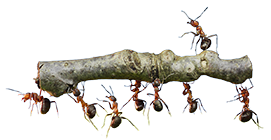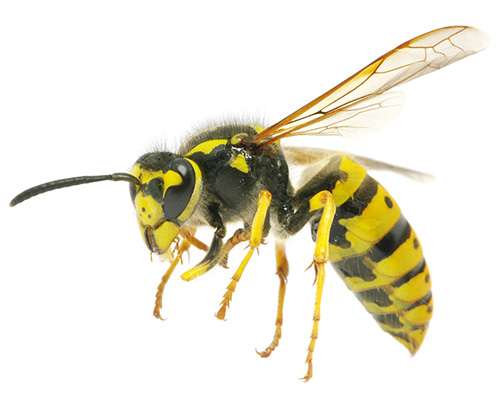
Eugene Wasp Control
We have all seen them, Paper Wasps hanging under the eaves of our homes, in trees, shrubs or coming in a stream from the groundcover. Some have made the painful mistake of trying to destroy the nest only to realize it was a big mistake. When agitated, believe me you do not want to do that, they will attack in mass leaving painful stings behind as you run for cover. Worst of all, they can sting multiple times because their stingers are like a needle and not like the barbed stinger of a Honeybee so they will repeatedly sting you. Ouch!
Called “paper wasp” because they strip wood from houses and fences then they reprocess the wood mixing it with their saliva making a papier-mâché type of material. Then they use this material to build the nest by making multiple layers of the paper into an envelope, which surrounds the core of the nest. With the addition of more eggs, the workers add new material to the outside to make room for the internal building of the nest.
It not just the outside of your home or in your garden area wasps can build a nest. They will also build nests in a nearby tree or under the eaves, even under the decks of your home. Wasps have been known to build their nests in a ceiling or wall void as well. They are busy building away for months before you realize they are even there. Sometimes it seems like they appear in mass almost overnight.
If they get into the attic of your house, you will begin to notice that wasps will gravitate toward the windows seeking a way to escape. They are also attracted to the overhead lighting because it appears to them as a way of escape. Getting in is sometimes accomplished when they nest in the ceiling. They travel in the ceiling void to a close light fixture where they have access to the inside of your home. You may even notice a slow-growing wet spot in the ceiling caused by the wasps building their nest. Do not be that curious homeowner that pokes or pushes their finger right through the deteriorating ceiling and end up with an unfortunate and horrifying surprise. The nest will fall through to the floor with hundreds of angry wasps viciously attacking anyone in the room. Whatever you do, run and run fast and slam the door behind you! Otherwise, they will follow you throughout the house stinging you as you run.
There are many species of wasps and generally they fall into one of two categories; one is a social wasp like the Yellow Jacket, Hornets and European Paper wasps that live in large communities governed by the queen. The other category is the solitary wasps, one such wasp is the Mud Dauber.
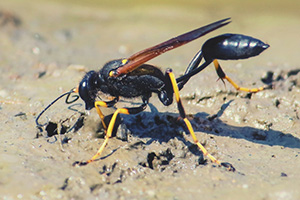
Mud Daubers
Mud Daubers(Chalybioncalifornicum)are metallic blue and as they flutter, their wings appear to flash metallic black. Seldom do they sting; they are not protective of their nests. The female builds a nest made up of mud in the form of tubes, about as round as a pencil and several inches long. While there may be multiple tubes, there are no workers to defend the nest. She will lay an egg in each tube, then will place a dead insect in with the egg and seal the tube. Once the larva hatches from the egg capsule, they have an immediate source of food awaiting them. When fully mature the female will mate, fly off repeating the cycle throughout the spring and summer months.
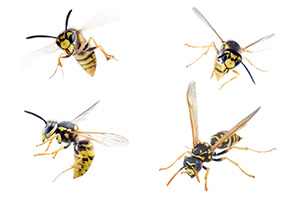
Yellow Jackets
Here in the Eugene area, Yellow Jackets (Vespula alascens is) are a primary pest that fall into the category of social wasps. This means there are hundreds of them, and when disturbed these angry wasps will defend their nest with fierce anger. Yellow Jackets are medium in size and are black with bright bands of yellow. One female reproductive will build a nest and by the end of their active season, the nests can reach populations approaching 15,000 wasps. Generally, they build their nest underground, in rotted wood and woodpiles or in railroad ties and retaining walls. Be careful because Yellow Jackets are crawlers and will do so right up your pants leg. So be aware they are not just flying they are also crawling and become trapped inside your pants giving you multiple stings. Here again, their stingers have no barbs and are used repeatedly to continue stinging.
If you disturb a nest and they are stinging you, leave the area as quickly as possible. Sounds reasonable? I have seen people being stung and they just stand there screaming and swinging their arms. You need to move quickly, and get out of the area! Once the sentry that guards the nest becomes aware of a threat, she will produce a pheromone that instructs all the worker wasps of a threat and they will, in mass, attack anyone or living animal within 50 feet or more.
Yellow Jackets are scavengers; they constantly fly around looking for food. Since they are meat eaters, your picnic area or barbeque is a prime target. They are not interested in sharing your food; they want it all and will challenge you for it. Any attempt in trying to swat them away from this food source may result in a painful sting. They also like soda as much as you do, be careful because they will crawl into your can and will sting you as you drink. A sting on the lips is very painful but if it stings you down your throat; it can lead to a medically serious problem that may need emergency treatment.
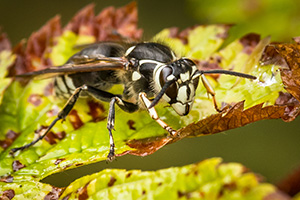
Hornets
Hornets(dolichovespulamaculate)or sometimes called a Bald Faced hornet. These are also a serious problem. They look very much like Yellow Jackets, just proportionally bigger. If one stings you, it will cause a considerable amount of pain. They are worse than Yellow Jackets, which will crawl up your pant leg to sting; Hornets on the other hand tend to go for your face and eyes. Initially they are less aggressive than Yellow Jackets, but they too can sting multiple times. Do not be the one to discover that their sting is many times more painful than that of other wasps.
Hornets are extremely aggressive if anything messes with their nest. So do not mess with their nest. Kids will sometimes throw a rock at a nest only to painfully discover that the Hornet will follow the trajectory of the stone right back to them. Run, as they will, they cannot out run the Hornet. The nest often reaches the size of a basketball and are usually found hanging under eves of houses, in the peak of a roof, in trees and bushes, and occasionally will build a nest in your attic. They are very difficult to deal with so it is always unwise to try to remove a hornets’ nest without experience or you may experience their wrath.
Like other wasps, as winter approaches the hornet nest dies out and is eventually abandoned. Once the fall night time temperatures reach consistently 42 degrees, the queens will begin to look for a suitable place to overwinter, one that is warm and secluded and well protected from the harshness of winter. In the spring, she may return to the same area but rarely to the same nest. Here in Oregon winter rains will destroy the old nest by spring, so the queen will build a new nest.
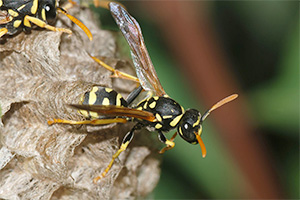
European Paper Wasp
In 1981,European Paper Wasp(Polistesdominula)was discovered in the U.S. and has since spread widely throughout the country. A social wasp, it will develop a rather large nest consisting of hundreds of workers. They too are extremely aggressive and can detect movement up to 20 feet from the nest. While aware of your close proximity, they will not become aggressive unless you are less than 12 inches from the nest.
Once disturbed they will come out in mass and sting any unfamiliar thing in the area, including the sprayer you dropped when running away from trying to spray them. They have yellow and black stripes, and sometimes they are mistaken for Yellow Jackets. One way they differ from Yellow Jackets who build their nest in the ground, the European Paper wasp will build its nests in wall voids, in holes in the house siding, or under the siding at the foundation.
Social wasps have their place in our environment. They are helpful in controlling a large number of other insects including spiders and even cockroaches. However, benefit is of little importance once they nest near your front door, or they start coming into your living space because they are nesting in a wall void and have found an access point through an electrical outlet or other similar areas.
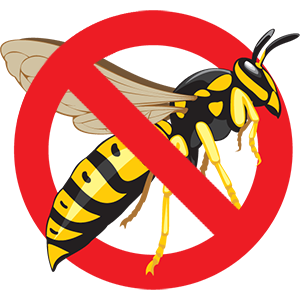
Now is the time to take control and to take action. However, do not make the unfortunate and painful mistake of trying to solve a problem with wasps yourself. One miscalculation cannot only be painful but could lead to a trip to an Emergency treatment center. Such a trip will be far more expensive than having a professional take care of your wasp problem.
Unlike most insect and pests, wasps can inflict some serious pain and damage to your body. In the severest of cases, their sting can even cause death. This is one problem you to not want to try to resolve yourself.
I have the right protective clothing, the right specialized equipment, the right materials and the right technology for a fast and safe solution to your wasp problem.
Eugene Wasp Control
If you have a problem with wasps, call me, Thad at Merle’s Pest Control 541-514-3027
Pest Navigator:
If you have seen any of these lately call me, Thad, and I will help you safely regain control over your home environment.

